|

from
Crytalinks Website
The symbol of the 4-sided swastika is an
archetype for the rotations of time and consciousness - moving
clockwise and counterwise - in upward or downward spirals - allowing
souls to experience many levels of reality simultaneously.

The word Swastika comes from the
Sanskrit words su, meaning well, and asti,
meaning to be.
The swastika is an equilateral cross with its arms bent at right
angles either clockwise or anticlockwise. It is traditionally
oriented so that a main line is horizontal, though it is
occasionally rotated at forty-five degrees, and the Hindu version
often has a dot in each quadrant.
The swastika has not always been used as a symbol of Nazism and was
in fact borrowed from Eastern cultures. It seems to have first been
used by early inhabitants of Eurasia. It is an important symbol in
Eastern religions, notably Hinduism and Buddhism, among others, and
was also used in Native American faiths before World War II.
By the
early twentieth century it was regarded worldwide as a symbol of
good luck and auspiciousness. Swastikas appeared on the spines of
books by the Anglo-Indian writer Rudyard Kipling, and the symbol was
used by Robert Baden-Powell's Boy Scout movement.
Since the rise of the National Socialist German Workers Party, the
swastika has been associated with fascism, racism,
World War II, and
the Holocaust in much of the western world. Before this, it was
particularly well-recognized in Europe from the archaeological work
of Heinrich Schliemann, who discovered the symbol in the site of
ancient Troy and who associated it with the ancient migrations of
Indo-European (Aryan) peoples.
Nazi use derived from earlier German völkisch nationalist movements, for which the swastika was a symbol
of "Aryan" identity, a concept that came to be equated by theorists
like Alfred Rosenberg with a Nordic master race originating in
northern Europe. The swastika remains a core symbol of Neo-Nazi
groups.
Since the end of World War II, the traditional uses of swastika in
the western world were discouraged. Many innocent people or products
were wrongly persecuted.
There have been failed attempts by
individuals and groups to educate Westerners to look past the
swastika's recent association with the Nazis to its prehistoric
origins.
Etymology and
alternative names
The word swastika is derived from the Sanskrit svastika, meaning any
lucky or auspicious object, and in particular a mark made on persons
and things to denote good luck.
It is composed of su- (cognate with
Greek ευ-), meaning "good, well" and asti a verbal abstract to the
root as "to be"; svasti thus means "well-being".
The suffix -ka
forms a diminutive, and svastika might thus be translated literally
as "little thing associated with well-being", corresponding roughly
to "lucky charm", or "thing that is auspicious". The word first
appears in the Classical Sanskrit (in the Ramayana and Mahabharata
epics).
Alternative historical English spellings of the Sanskrit word
include suastika and svastica. Alternative names for the shape are:
-
Crooked cross
-
Cross cramponned - in heraldry,
as each arm resembles a crampon or angle-iron
-
Cross gammadion - tetragammadion
or just gammadion, as each arm resembles the Greek letter
(gamma)
-
Fylfot - meaning "four feet",
chiefly in heraldry and architecture
-
Sun wheel - German Sonnenrad - a
name also used as a synonym for the sun cross
-
Tetraskelion - Greek "four
legged", especially when composed of four conjoined legs
-
Thor's hammer - from its
supposed association with Thor, the Norse god of thunder,
but this may be a misappropriation of a name that properly
belongs to a Y-shaped or T-shaped symbol. - The Swastika
shape appears in an 8th century Icelandic grimoire where in
it is named Þurs Hamar
-
Hooked cross - (Dutch:
hakenkruis, Icelandic Hakakross, German: Hakenkreuz,
Finnish: hakaristi, Norwegian: Hakekors, Italian: croce
uncinata and Swedish: Hakkors)
-
Black Spider - to various
peoples in middle and western Europe
History
The swastika appears in art and design from pre-history symbolizing,
in various contexts: luck, the sun, Brahma, or the Hindu concept of
samsara.
In antiquity, the swastika was used extensively by
Hittites, Celts and Greeks, among others. It occurs in other Asian,
European, African and Native American cultures sometimes as a
geometrical motif, sometimes as a religious symbol. Today, the
swastika is a common symbol in Hinduism, Buddhism and Jainism, among
others.
The ubiquity of the swastika has been explained by three main
theories: independent development, cultural diffusion, and external
event. The first theory is that the swastika's symmetry and
simplicity led to its independent development everywhere, along the
lines of Carl Jung's collective unconscious, or just as a very
simple symbol.
Another explanation is suggested by
Carl Sagan in his book Comet.
Sagan reproduces an ancient Chinese manuscript that shows comet tail
varieties: most are variations on simple comet tails, but the last
shows the comet nucleus with four bent arms extending from it,
recalling a swastika. Sagan suggests that in antiquity a comet could
have approached so close to Earth that the jets of gas streaming
from it, bent by the comet's rotation, became visible, leading to
the adoption of the swastika as a symbol across the world.
Theories of single origin as a sacred prehistorical symbol point to
the Proto-Indo-Europeans, noting that the swastika was not adopted
by Sumer in Mesopotamia, which was established no later than 3500
BC, and the Old Kingdom of Egypt, beginning in 2630 BC, arguing that
these were already well-established and codified at the time of the
symbol's diffusion. As an argument ex silentio, this point has
little value as a positive proof.
The swastika symbol is prominent in Hinduism, which is considered
the parent religion of Buddhism and Jainism, both dating from about
the sixth century BC, and both borrowing the swastika from their
parent. Buddhism in particular enjoyed great success, spreading
eastward and taking hold in southeast Asia, China, Korea and Japan
by the end of the first millennium.
The use of the swastika by the
indigenous Bön faith of Tibet, as well as syncretic religions, such
as Cao Dai of Vietnam and Falun Gong of China, is thought to be
borrowed from Buddhism as well. Similarly, the existence of the
swastika as a solar symbol among the Akan civilization of southwest
Africa may have been the result of cultural transfer along the
African slave routes around 1500 AD.
Regardless of origins, the swastika had generally positive
connotations from early in human history, with the exceptions being
most of Africa and South America.
Adoption of
the swastika in the West
The discovery of the Indo-European language group in the 1800s led
to a great effort by archaeologists to link the pre-history of
European peoples to the ancient Aryans.
Following his discovery of
objects bearing the swastika in the ruins of Troy, Heinrich
Schliemann consulted two leading Sanskrit scholars of the day,
Emile Burnouf and Max Müller.
Schliemann concluded that the swastika was a
specifically Aryan symbol. This idea was taken up by many other
writers, and the swastika quickly became popular in the West,
appearing in many designs from the 1880s to the 1920s.
The positive meanings of the symbol were subverted in the early
twentieth century when it was adopted as the emblem of the National
Socialist German Workers Party.
This association occurred because Nazism stated that the historical Aryans were the modern Germans and
then proposed that, because of this, the subjugation of the world by
Germany was desirable, and even predestined.
The swastika was used
as a convenient symbol to emphasize this mythical Aryan-German
correspondence.
Since World War II, most Westerners see the swastika
as solely a Nazi symbol, leading to incorrect assumptions about its
pre-Nazi use and confusion about its current use in other cultures.
Geometry and
Symbolism
A right-facing swastika may be described as "clockwise"...... or
"counter-clockwise". A swastika composed of 17 squares in a 5x5 grid.
Geometrically, the swastika can be regarded as an irregular icosagon
or 20-sided polygon. The arms are of varying width and are often
rectilinear (but need not be). Only in modern use are the exact
proportions considered important: for example, the proportions of
the Nazi swastika were based on a 5x5 grid.
The swastika is chiral, with no reflectional symmetry, but both
mirror-image forms have 90° rotational symmetry (that is, the
symmetry of the cyclic group C4).
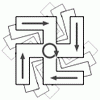
A right-facing
swastika may be described as "clockwise"...
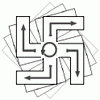
.. or "counter-clockwise"

A swastika composed of 17 squares in a 5x5 grid
The mirror-image forms are often
described as:
"Left-facing" and "right-facing" are
used mostly consistently.
Looking at an upright swastika, the upper
arm clearly faces towards the viewer's left (SM) or right (SP). The
other two descriptions are ambiguous as it is unclear if they refer
to the direction of the bend in each arm or to the implied rotation
of the symbol. If the latter, the question as to whether the arms
lead or trail remains. The terms are used inconsistently (sometimes
even by the same writer) which is confusing and may obfuscate an
important point, that the rotation of the swastika may have symbolic
relevance.
The swastika is, after the simple equilateral cross (the "Greek
cross"), the next most commonly found version of the cross.
Seen as a cross, the four lines emanating from the center point to
the four cardinal directions. The most common association is with
the Sun.
Other proposed correspondences are to the visible rotation
of the night sky in the Northern Hemisphere around Polaris.
Sauwastika
The name sauwastika is sometimes given for the supposedly "evil",
left-facing, form of the swastika (SM).
However, the evidence for
sauwastika seems sketchy and there seems to be very little other
than conjecture to support the notion that the left-facing swastika
is regarded as evil in Hindu tradition. Although the more common
form is the right-facing swastika, Hindus all over India and Nepal
still use the symbol in both orientations for the sake of balance.
Buddhists almost always use the left-facing swastika.
Some contemporary writers - Servando Gonzalez, for example - confuse
matters even further by asserting that the right-facing swastika,
used by the Nazis is in fact the "evil" sauwastika. (Gonzalez
"proves" that the left-facing swastika is the sunwise one with
reference to a 1930s box of Standard fireworks from Sivakasi,
India.)
This inversion whether intentional or not might derive
from a desire to prove that the Nazi's use of the right-handed
swastika was expressive of their "evil" intent.
But the notion that
Adolph Hitler deliberately inverted the "good left-facing" swastika
is wholly unsupported by any historical evidence.
Art and
Architecture
The swastika is common as a design motif in current Hindu
architecture and Indian artwork as well as in ancient Western
architecture, frequently appearing in mosaics, friezes, and other
works across the ancient world.
Ancient Greek architectural designs
are replete with interlinking swastika motifs. Related symbols in
classical Western architecture include the cross, the three-legged
triskele or triskelion and the rounded lauburu.
The swastika symbol
is also known in these contexts by a number of names, especially
gammadion. Pictish rock carvings, adorning ancient Greek pottery,
and on Norse weapons and implements.
It was scratched on cave walls
in France seven thousand years ago.
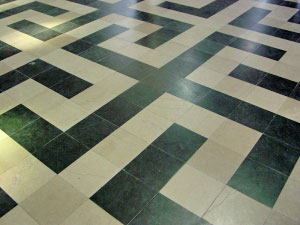
In Chinese, Korean, and Japanese art,
the swastika is often found as part of a repeating pattern.
One
common pattern, called sayagata in Japanese, comprises left and
right facing swastikas joined by lines. As the negative space
between the lines has a distinctive shape, the sayagata pattern is
sometimes called the "key fret" motif in English.
The swastika symbol was found extensively in the ruins of the
ancient city of Troy.
In Greco-Roman art and architecture, and in Romanesque and Gothic
art in the West, isolated swastikas are relatively rare, and the
swastika is more commonly found as a repeated element in a border or
tesselation. A design of interlocking swastikas is one of several
tesselations on the floor of the cathedral of Amiens, France.
A
border of linked swastikas was a common Roman architectural motif,
and can be seen in more recent buildings as a neoclassical element.
A swastika border is one form of meander, and the individual
swastikas in such border are sometimes called Greek Keys.
The Laguna Bridge in Yuma, Arizona was built in 1905 by the U.S.
Reclamation Department and is decorated with a row of swastikas.
The Canadian artist ManWoman has attempted to rehabilitate the
"gentle swastika."
Religion and
Mythology
Hinduism
The swastika is found all over Hindu temples, signs, altars,
pictures and iconography in India and Nepal, where it remains
very popular.
It is considered to be the second most sacred symbol in
Hinduism, behind the Om symbol. In Hinduism, the two symbols
represent the two forms of the creator god Brahma: clockwise it
represents the evolution of the universe (Pravritti),
anti-clockwise it represents the involution of the universe (Nivritti).
It is also seen as pointing in all four directions (North, East,
South and West) and thus signifies stability and groundedness.
Its use as a sun symbol can first be seen in its representation
of Surya, the Hindu lord of the Sun.
The swastika is considered extremely holy and auspicious by all
Hindus, and is regularly used to decorate all sorts of items to
do with Hindu culture.
It is used in all Hindu yantras and religious designs.
Throughout the subcontinent of India it can be seen on the sides
of temples, written on religious scriptures, on gift items, and
on letterhead.
The Hindu God Ganesh is closely associated with the symbol of
the swastika.
Amongst the Hindus of Bengal, it is common to see the name
"swastika" applied to a slightly different symbol, which has the
same significance as the common swastika, and both symbols are
used as auspicious signs. This symbol looks something like a
stick figure of a human being.
"Swastika" is a common given name amongst Bengalis and a
prominent literary magazine in Calcutta is called the Swastika.
Buddhism
In Buddhism, the swastika is oriented horizontally.
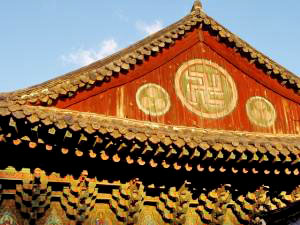
These two symbols are included, at
least since the Liao dynasty, as part of the Chinese language,
the symbolic sign for the character meaning "all", and
"eternality" (lit. myriad) and as SP which is seldom used.
A swastika marks the beginning of many Buddhist scriptures.
The swastikas (in either orientation) appear on the chest of
some statues of Gautama Buddha and is often incised on the soles
of the feet of the Buddha in statuary.
Because of the association with the right facing swastika with
Nazism, Buddhist swastikas after the mid 20th century are almost
universally left-facing.
This form of the swastika is often found on Chinese food
packaging to signify that the product is vegetarian and can be
consumed by strict Buddhists. It is often sewn into the collars
of Chinese children's clothing to protect them from evil
spirits.
Additionally, the left-facing swastika is found on Japanese maps
to indicate a temple.
The swastika used in Buddhist art and scripture is known in
Japanese as a manji, and represents Dharma, universal harmony,
and the balance of opposites. When facing left, it is the omote
(front) manji, representing love and mercy.
Facing right, it represents strength and intelligence, and is
called the ura (rear) manji. Balanced manji are often found at
the beginning and end of Buddhist scriptures.
Jainism
In Jainism, the swastika symbol is the only holy symbol.
Jainism
does not use the Hindu om symbol at all and thus gives even more
prominence to the swastika than Hinduism. It is a symbol of the
seventh Jina (Saint), the Tirthankara Suparsva.
It is considered
to be one of the 24 auspicious marks and the emblem of the
seventh arhat of the present age. All Jain temples and holy
books must contain the swastika and ceremonies typically begin
and end with creating a swastika mark several times with rice
around the altar.
The Abrahamic religions
The swastika was not
widely utilized by followers of the Abrahamic religions.
Where
it does exist, it is not portrayed as an explicitly religious
symbol and is often purely decorative or, at most, a symbol of
good luck. The floor of the synagogue at Ein Gedi, built during
the Roman occupation of Judea, was decorated with a swastika.
Some Christian churches built in the Romanesque and Gothic eras
are decorated with swastikas, carrying over earlier Roman
designs. Swastikas are prominently displayed in a mosaic in the
St. Sophia church of Kiev, Ukraine dating to the 12th century.
They also appear as a repeating ornamental motif on a tomb in
the Basilica of St. Ambrose in Milan.
The Muslim "Friday" mosque
of Isfahan, Iran and the Taynal Mosque in Tripoli, Lebanon both
have swastika motifs.
Other Asian
Traditions
China
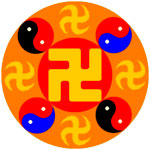
Falun Gong Emblem
Some sources indicate that the
Chinese Empress Wu (684-704) of the Tang Dynasty decreed that
the swastika would be used as an alternative symbol of the sun.
The Chinese character SP has developed into the modern one e¼,
pronounced f ng in Standard Mandarin, and has the main meaning
of "square". As part of the Chinese script, the swastika has
Unicode encodings U+534D SM (left-facing) and U+5350 SP
(right-facing).
The left-facing Buddhist swastika also appears on the emblem of Falun Gong. This has generated considerable controversy,
particularly in Germany, where the police have reportedly
confiscated several banners featuring the emblem.
A court
ruling subsequently allowed Falun Gong followers in Germany to
continue the use of the emblem.
Japan
In Japan, the swastika is called manji (SM).
On Japanese town
plans, a swastika (left-facing and horizontal) is commonly used
to mark the location of a Buddhist temple. The right-facing manji is often referred as the gyaku manji ("reverse manji"),
and can also be called kagi jokji, literally "hook cross." A
PokEmon playing card sold in Japan had a manji graphic.
Because
of its resemblance to the Nazi swastika (see below), the card
was altered for Western translations, and eventually withdrawn
in Japan following Western complaints.
Similarly, a manji symbol
was incorporated as a level design in both the Japanese and U.S.
versions of the 1986 The Legend of Zelda video game.
Native American Traditions
The swastika was a widely used Native American symbol. It has
been found in excavations of Mississippian-era sites in the Ohio
valley.
It was widely used by many southwestern tribes, most
notably the Navajo. Among different tribes the swastika carried
various meanings. To
the Hopi it represented the wandering Hopi
clans; to
the Navajo it was one symbol for a
whirling log (tsil
no'oli'), a sacred image representing a legend that was used in
healing rituals.
From The Book of the Hopi
by Frank Waters
The swastika symbol
represents the path of the migrations of the Hopi clans.
The center of the cross represents Tuwanasavi or the Center of
the Universe which lay in what is now the Hopi country in the
southwestern part of the US. Tuwanasavi was not the geographic
center of North America, but the magnetic or spiritual center
formed by the junction of the North-South and the East-West axis
along which the Twins sent their vibratory messages and
controlled the rotation of the planet.
Three directions (pasos) for most of the clans were the same:
the ice locked back door to the north, the Pacific Ocean to the
west and the Atlantic Ocean to the east.
Only 7 clans-the Bear, Eagle, Sun, Kachina, Parrot, Flute and
Coyote clans-migrated to South America to the southern paso at
it's tip. The rest of some 40 clans, having started from
somewhere in southern Mexico or Central America, regarded this
as their southern paso, their migration thus forming a balanced
symbol.
Upon arriving at each paso all the leading clans turned right
before retracing their routes.
Pre-Christian European Traditions
The swastika, also known
as the fylfot in northwestern Europe, appears on many
pre-Christian artifacts, drawn both clockwise and
counterclockwise, within a circle or in a swirling form.
The
Greek goddess Athena was sometimes portrayed as wearing robes
covered with swastikas.
The "Ogham stone" found in County Kerry,
Ireland is inscribed with several swastikas dating to the fifth
century AD, and is believed to have been an altar stone of the
Druids. The pre-Christian Anglo-Saxon ship burial at Sutton Hoo,
England, contains gold cups and shields bearing swastikas.
Today
it is used as a symbol for Asatru, the reconstructed religion of
Northern Europe.
Early 20th Century
Europe
The British author Rudyard Kipling, who was strongly influenced
by Indian culture, had a swastika on the dust jackets of all his
books until the rise of Nazism made this inappropriate.
One of
Kipling's Just So Stories, "The Crab That Played With The Sea",
had an elaborate full-page illustration by Kipling including a
stone bearing what was called "a magic mark" (a swastika); some
later editions of the stories blotted out the mark, but not its
captioned reference, making the readers wonder what the "mark"
was.
The Russian Provisional Government of 1917 printed a number of
new bank notes with right-facing diagonally-rotated swastikars
in their centres. Some have suggested that this may have been
the inspiration behind the Nazis adoption of this symbol as
Alfred Rosenberg was in Russia at this time.
It was also used as a symbol by the Boy Scouts in Britain, and
worldwide. According to "Johnny" Walker,[14] the earliest
Scouting use was on the first Thanks Badge introduced in 1911.
Robert Baden-Powell's 1922 Medal of Merit design adds a swastika
to the Scout fleur-de-lis as good luck to the person receiving
the medal. Like Kipling, he would have come across this symbol
in India.
During 1934 many Scouters requested a change of design because
of the use of the swastika by the Nazis. A new British Medal of
Merit was issued in 1935.
The Lotta Svard emblem was designed by Eric Wasstrom in 1921. It
includes the swastika and heraldic roses.
During World War I, the swastika was used as the emblem of the
British National War Savings Committee.
In Finland the swastika was used as the official national
marking of the Finnish Air Force and Army between 1918 and 1944.
The swastika was also used by the Lotta Svard organization.
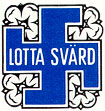
The blue swastika was the good luck
symbol used by the Swedish Count Erich von Rosen, who donated
the first plane to the Finnish White Army during the Civil War
in Finland.
It has no connection to the Nazi use of the
swastika. It also still appears in many Finnish medals and
decorations. In the very respected wartime medals of honor it
was a visible element, first drafted by Axel Gallen-Kallela
1918-1919.
Mannerheim cross with a swastika is
the Finnish equivalent of Victoria Cross, Croix de Guerre and
Congressional Medal of Honor. Due to Finland's alliance with
Nazi Germany in World War II, the symbol was abandoned as a
national marking, to be replaced by a roundel.
The Swedish company ASEA, now a part of Asea Brown Boveri, used
the swastika in its logo from the 1800s to 1933, when it was
removed from the logo.
In Latvia too, the swastika (known as Thunder Cross and
Fire
Cross) was used as the marking of the Latvian Air Force between
1918 and 1934, as well as in insignias of some military units.
It was also used by the Latvian fascist movement Perkonkrusts
(Thunder Cross in Latvian), as well as by other non-political
organizations.
The Icelandic Steamship Company, Eimskip (founded in 1914) used
a swastika in its logo until recently.
In Dublin, Ireland, a laundry company known as the Swastika
Laundry was in existence on the south side of the city.
Featuring a black swastika on a white background, the business
started up in the early 20th century and continued up until
recent times.
North America
The Theosophical Society, founded in New York in 1875,
incorporated the Swastika into its seal because of the Buddhist
associations of the symbol.
The swastika's use by the Navajo and other tribes made it a
popular symbol for the American Southwest. Until the 1930s
blankets, metalwork, and other Southwestern souvenirs were
often made with swastikas.
One year in the first part of the 20th century, the Corn Palace
in Mitchell, South Dakota featured a design that had a swastika
on one of the towers.
Swastika is the name of a small community in northern Ontario,
Canada, approximately 580 kilometers north of Toronto, and 5
kilometers west of Kirkland Lake, the town of which it is now
part. The town of Swastika was founded in 1906. Gold was
discovered nearby and the Swastika Mining Company was formed in
1908. The government of Ontario attempted to change the town's
name during World War II, but the town resisted.
In Windsor, Nova Scotia, there was an ice hockey team from
1905-1916 named the Swastikas, and their uniforms featured
swastika symbols. There were also hockey teams named the
Swastikas in Edmonton, Alberta (circa 1916), and Fernie, British
Columbia (circa 1922).
The 45th Infantry Division of the United States Army used a
yellow swastika on a red background as a unit symbol until the
1930s, when it was switched to a thunderbird.
In 1925, Coca Cola made a lucky watch fob in the shape of a
swastika with the slogan, "Drink Coca Cola five cents in
bottles".
The Health, Physical Education and Recreation Building (HPER) at
Indiana University contains decorative Native American-inspired
reverse swastika tilework on the walls of the foyer and
stairwells on the southeast side of the building. HPER was built
as the university fieldhouse in the 1920's, before the Nazi
party came to power in Germany. In recent years, the HPER
swastika motif, along with the Thomas Hart Benton murals in
nearby Woodburn Hall have been the cause of much controversy on
campus.
Nazi Germany
The National Socialist German Workers Party (Nationalsozialistische
Deutsche Arbeiterpartei or NSDAP) formally adopted the swastika
or Hakenkreuz (hooked cross) in 1920. This was used on the
party's flag (right), badge, and armband.
(It had been used
unofficially by the NSDAP and its predecessor, the German
Workers Party, Deutsche Arbeiterpartei (DAP), however.)
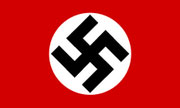
In Mein Kampf, Adolph Hitler wrote:
I myself, meanwhile, after
innumerable attempts, had laid down a final form; a flag
with a red background, a white disk, and a black swastika in
the middle. After long trials I also found a definite
proportion between the size of the flag and the size of the
white disk, as well as the shape and thickness of the
swastika.
Red, white, and black were the
colors of the flag of the old German Empire.
The use of the swastika was associated by Nazi theorists with
their conjecture of Aryan cultural descent of the German people.
Following the Nordicist version of the Aryan invasion theory,
the Nazis claimed that the early Aryans of India, from whose
Vedic tradition the swastika sprang, were the prototypical white
invaders. Thus, they saw fit to co-opt the sign as a symbol of
the Aryan master race.
The use of swastika as a symbol of
the Aryan race dates back to writings of Emile Burnouf.
Following many other writers, the German nationalist poet Guido
von List believed it to be a uniquely Aryan symbol. Hitler
referred to the swastika as the symbol of "the fight for the
victory of Aryan man" - Mein Kampf.
The swastika was already in use as a symbol of German volkisch
nationalist movements. In Deutschland Erwache - Ulric of England
writes:
...what inspired Hitler to use
the swastika as a symbol for the NSDAP was its use by the
Thule-Gesellschaft since there were many connections between
them and the DAP... from 1919 until the summer of 1921 Hitler
used the special Nationalsozialistische library of Dr.
Friedich Krohn, a very active member of the Thule-Gesellschaft.
Dr. Krohn was also the dentist from Sternberg who was
named by Hitler in Mein Kampf as the designer of a flag very
similar to one that Hitler designed in 1920 during the
summer of 1920, the first party flag was shown at Lake
Tegernsee ... these home-made early flags were not
preserved, the Ortsgruppe München flag was generally
regarded as the first flag of the Party.
José Manuel Erbez wrote:
The first time the swastika was
used with an "Aryan" meaning was on December 25, 1907, when
the self-named Order of the New Templars, a secret society
founded by [Adolf Joseph] Lanz von Liebenfels, hoisted at
Werfenstein Castle (Austria) a yellow flag with a swastika
and four fleurs-de-lys.
However, Liebenfels was drawing on
an already-established use of the symbol.
NSDAP flags at the 1936 Nazi Party rally in Nuremberg. On 14 March
1933, shortly after Hitler's appointment as Chancellor of
Germany, the NSDAP flag was hoisted alongside Germany's national
colors. It was adopted as the sole national flag on 15 September
1935.
The swastika was used for badges and flags throughout Nazi
Germany, particularly for government and military organizations,
but also for "popular" organizations such as the Reichsbund
Deutsche Jagerschaft.
Nazi Party rally in Nuremberg. On 14 March 1933, shortly after
Hitler's appointment as Chancellor of Germany, the NSDAP flag
was hoisted alongside Germany's national colors. It was adopted
as the sole national flag on 15 September 1935.
The swastika was
used for badges and flags throughout Nazi Germany, particularly
for government and military organizations, but also for
"popular" organizations such as the Reichsbund Deutsche
Jägerschaft.

The Iron Cross
featured a swastika during the Nazi period
The Iron Cross featured a swastika
during the Nazi period - while the DAP and the NSDAP had used
both right-facing and left-facing swastikas, the right-facing
swastika is used consistently from 1920 onwards.
However, Ralf Stelter notes that the swastika flag used on land had a
right-facing swastika on both sides, while the ensign (naval
flag) had it printed through so that you would see a left-facing
swastika when looking at the ensign with the flagpole to the
right.
There were attempts to amalgamate Nazi and Hindu use of the
swastika. Notably by Savitri Devi Mukherji who declared Hitler
an avatar of Vishnu.
Taboo in Western Countries
Because of its use by Hitler and the Nazis and, in modern times,
by neo-Nazis and other hate groups, for many people in the West,
the swastika is associated primarily with Nazism, fascism, and
white supremacy in general. Hence, outside historical contexts,
it has become taboo in Western countries.
For example, the
German postwar criminal code makes the public showing of the Hakenkreuz (the swastika) and other Nazi symbols illegal and
punishable, except for scholarly reasons.
The powerful symbolism acquired by the swastika has often been
used in graphic design and propaganda as a means of drawing Nazi
comparisons; examples include the cover of Stuart Eizenstat's
2003 book Imperfect Justice, publicity materials for Costa-Gavras's
2002 film Amen, and a billboard that was erected opposite the
U.S. Interests Section in Havana, Cuba, in 2004, which
juxtaposed images of the Abu Ghraib prisoner abuse pictures with
a swastika.
Founded in the 1970s, the Raelian Movement, a religious sect
believing in the possibility of immortality by scientific
progress, used a symbol that was the source of considerable
controversy: an interlaced Star of David and swastika. In 1991,
the symbol was changed to remove the swastika and deflect public
criticism.
The Society for Creative Anachronism, which aims to
study and recreate Medieval and Renaissance history, imposes
restrictions on its members' use of the swastika on their arms,
although some arms dating to the early days of the group have
the symbol.

Raelian Symbol
The Raëlian symbol, before 1991 and after recent years,
controversy has erupted when consumer goods bearing the symbol
have been exported (often unintentionally) to North America.
In
2002, Christmas crackers containing plastic toy pandas sporting
swastikas were pulled from shelves after complaints from
consumers in Canada, although the China-based manufacturer
claimed the symbol was presented in a traditional sense and not
as a reference to the Nazis.
In 1995, the City of Glendale, California scrambled to cover up
over 900 cast iron lampposts decorated with swastikas throughout
the downtown portion of the city; the lampposts had been
manufactured by an American company in the early 1920s, and had
nothing to do with Nazism.
In 2004, Microsoft released a "critical update" to remove two
swastikas and a Star of David from the font Bookshelf Symbol 7.
The font had been bundled with Microsoft Office 2003.
Punk rockers like Siouxsie Sioux, Sid Vicious and John Lydon
used, and were photographed using, the Nazi version of the
swastika for its shock value, notwithstanding that Malcolm
McLaren, the Sex Pistols' manager, was half-Jewish.
The previously successful career of the British band Kula Shaker
virtually collapsed in the 1990s after the band's frontman,
Crispian Mills, son of actress Hayley Mills, expressed his
desire to use Swastikas as part of the imagery of their live
show; because of this, and additional remarks he made, he was
widely accused of holding Nazi sympathies.
However, the band was musically influenced by Indian styles, and
Mills asserted that his attraction to the swastika was part of
an attempt to reclaim the Indian usage of the symbol in the
West.
In January 2005 there was much criticism when Prince Harry of
Wales, third in line of succession to the British throne, was
photographed wearing what appeared to be intended as an Afrika
Korps uniform, plus a Nazi swastika armband, to a fancy dress
party.

The Swastika
Stone
The stone overlooks the valley of the
River Wharfe, and is identical to some of the 'Camunnian Rose'
designs in Val Camonica, Italy - nine cup-marks in a cross shape,
surrounded by a curved swastika-shaped groove.
The Ilkley carving
also has an 'appendage' off the east arm - a cup surrounded by a
curved hook-shaped groove. It is unique on the moor (which is
covered in hundreds of cup-and-ring type carvings) although there is
an unfinished swastika design (more angular, without cups) on the
nearby Badger Stone.
One of the lines of cups on the Swastika Stone is less than a degree
off magnetic north-south.
One naturally looks north from the stone,
as it is on a rocky outcrop on the north side of the moor.
-
Was it
associated with the Pole Star with which its cups align?
-
Why then
does its shape describe a clockwise motion, whereas the stars turn
anti-clockwise around the pole?
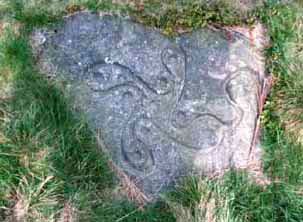
Iron Age Rock Carving
The stone is found in the moors near Ilkley in West Yorkshire.
Perhaps the design relates to the shamanic practice of ascent up the
'Pillar of the World' (to use the Lapp term).
Numerous Siberian and
northern European peoples documented by Mircea Eliade see the Pole
Star as the summit of a pole holding up the sky (seen as a tent).
Eliade notes similar beliefs about the
Pole Star in Ancient Saxon, Scandinavian and Romanian myths. If,
then, one imagines the Swastika design to be the base of a Pillar of
the World, the implicit motion of the design makes sense. Something
that appears to turn anti-clockwise when looking up from the bottom
of a pole will, if it slides down the pole and is viewed from above,
appear to turn clockwise.
The Swastika Stone may map the turning sky down onto the ground,
forming the bond between 'levels' that is so central to shamanic
cosmology.
Also, the 'appendage' cup, in relation to the central cup, would
have only been a couple of degrees off the summer solstice sunrise
during the period 2000BCE - 100CE (covering most of the likely times
at which the glyph was carved. The 'hook' groove, if imagined to
turn with the swastika, would 'haul' the cup-sun across the sky.
This seems to strengthen the swastika-sky connection.
(I should note that I do not support the idea that cup-and-ring
patterns are maps of stellar constellations. Perhaps some involved
rudimentary attempts at this, but no one has found accurate
correspondences in any existing patterns. They seem to me to be more
generally concerned with access points to alternate realities).
With the Pole Star/Pillar of the World ideas in mind, one could see
some cup-and-ring markings as being related.
The 'tail' grooves
could be the Pillar reaching up to the cup-pole, surrounded by rings
of revolving stars. Some local cup-and-ring markings, like those on
the Panorama Stone, have 'ladders' instead of 'tail' grooves.
This
image further supports the shamanic interpretation of the petroglyphs, as ladders are among the most frequently occurring
representations of shamanic ascent to other worlds. Human figures
atop ladders appear in !Kung San rock art related to trance-state
ascension.
Cup-and-ring style petroglyphs in the British Isles are usually
dated to the Bronze Age (because some are included in, or in the
proximity of, Bronze Age burials) or the Neolithic (because of
comparable carvings on Irish passage graves from that period - see
also Richard Bradley's recent work 'Signing the Land' for arguments
dating this style of prehistoric art to the Neolithic).
The Swastika Stone is arguably associated with this style of rock
art, due to its use of cup-marks, but I have recently come to see it
as most likely originating in the Iron Age, or even during Roman
occupation. This is because of Verbeia, a Romano-Celtic goddess
revered by the Roman troops stationed in Ilkley (then Olicana).
Verbeia is often accepted as being a version of the Celtic
spring/fire goddess Brigid, who is still associated with
swastika-like symbols in Ireland. Also, the Roman cohort which set
up her altar were recruited from the Lingones, a Gaulish Celtic
tribe.
Apparently Romano-Celtic coins have been found in Gaul bearing
swastika-like designs. It seems tempting to think that the Lingones
cohort carved the Swastika Stone when they were here, but this would
surely be unusual.
Or perhaps the recruited Celtic/Roman troops were
influenced in their choice of 'genuis loci', Verbeia, by the native
Celts of West Yorkshire, the Brigantes (whose name derives from the
goddess Brigantia, related to Brigid), who may have already carved
the stone.
The Swastika may map the turning sky down onto the ground, forming
the bond between 'levels' that is so central to shamanic cosmology.
Spiritual
Secrets in the Carbon Atom - The Swastika
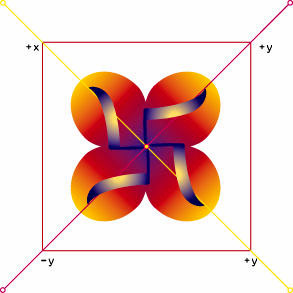
Legend has it that the Vedic
civilization was highly advanced.
The sages that oversaw its
development, through their mystic insight and deep meditation,
discovered the ancient symbols of spirituality - Aumkara and
Swastika. They also discovered many scientific principles
that they applied to develop a highly advanced technology.
They gave the atom its sanskrit name "Anu".
|















